Landslide-Hazard-Avoiding Highway Alignment Selection in Mountainous Regions Based on SAR Images and High-Spatial-Resolution Precipitation Datasets: A Case Study in Southwestern China
Abstract
:1. Introduction
2. Study Area and Data Sources
2.1. Study Area
2.2. SAR Data Sources
2.3. CRU and WorldClim Datasets
3. Methods
3.1. Data Selection
3.2. CSI
3.2.1. PS Target Selection
3.2.2. DS Target Selection
- (1)
- SHP identification
- (2)
- Estimation of the optimal phase
3.2.3. Combination of PS and DS Targets
3.3. HSRP Analysis
3.4. Alignment Selection
4. Results and Analysis
4.1. Results of the FS and Data Selection
4.2. Results of CSI and HSRP
4.3. Analysis of a Typical Landslide
4.4. Landslide-Hazard-Avoiding Alignment Selection
5. Discussion
5.1. Advantages
5.2. Limitations and Further Directions
6. Conclusions
Author Contributions
Funding
Data Availability Statement
Acknowledgments
Conflicts of Interest
References
- Confuorto, P.; Angrisani, A.; Novellino, A.; Infante, D.; Calcaterra, D. A Combined Procedure Using Satellite-Based Differential SAR Interferometry and Field Measurements for Landslide Characterization in Small Urban Settings. In Proceedings of the FRINGE 2017, Helsinki, Finland, 5–9 June 2017. [Google Scholar]
- Nikolaeva, R.V. Road safety as a factor in the socio-economic development of the country. IOP Conf. Ser. Mater. Sci. Eng. 2020, 786, 012070. [Google Scholar] [CrossRef]
- Ismail, K.; Sayed, T. Risk-optimal highway design: Methodology and case studies. Saf. Sci. 2012, 50, 1513–1521. [Google Scholar] [CrossRef]
- Yin, C.; Zhang, J. Hazard regionalization of debris-flow disasters along highways in China. Nat. Hazards 2018, 91, 129–147. [Google Scholar] [CrossRef]
- Pandey, V.K.; Sharma, M.C. Probabilistic landslide susceptibility mapping along Tipri to Ghuttu highway corridor, Garhwal Himalaya (India). Remote Sens. Appl. Soc. Environ. 2017, 8, 1–11. [Google Scholar] [CrossRef]
- Tang, H.; Gong, W.; Li, C.; Wang, L.; Juang, C.H. A new framework for characterizing landslide deformation: A case study of the Yu-Kai highway landslide in Guizhou, China. Bull. Eng. Geol. Environ. 2018, 78, 4291–4309. [Google Scholar] [CrossRef]
- Huang, Y.; Yi, S.; Li, Z.; Shao, S.; Qin, X. Design of highway landslide warning and emergency response systems based on UAV. In Proceedings of the Seventeenth China Symposium on Remote Sensing, Hangzhou, China, 27–31 August 2010; International Society for Optics and Photonics: Bellingham, WA, USA, 2011. [Google Scholar]
- Xu, C.; Tian, Y.; Zhou, B.; Ran, H.; Lyu, G. Landslide damage along Araniko Highway and Pasang Lhamu Highway and regional assessment of landslide hazard related to the Gorkha, Nepal earthquake of 25 April 2015. Geoenviron. Disasters 2017, 4, 14. [Google Scholar] [CrossRef]
- Psomiadis, E.; Papazachariou, A.; Soulis, K.X.; Alexiou, D.S.; Charalampopoulos, I. Landslide mapping and susceptibility assessment using geospatial analysis and earth observation data. Land 2020, 9, 133. [Google Scholar] [CrossRef]
- Qiu, H.; Su, L.; Tang, B.; Yang, D.; Ullah, M.; Zhu, Y.; Kamp, U. The effect of location and geometric properties of landslides caused by rainstorms and earthquakes. Earth Surf. Process. Landf. 2024; early view. [Google Scholar] [CrossRef]
- Ye, B.; Qiu, H.; Tang, B.; Liu, Y.; Liu, Z.; Jiang, X.; Yang, D.; Ullah, M.; Zhu, Y.; Kamp, U. Creep deformation monitoring of landslides in a reservoir area. J. Hydrol. 2024, 632, 130905. [Google Scholar] [CrossRef]
- Liu, Y.; Qiu, H.; Kamp, U.; Wang, N.; Wang, J.; Huang, C.; Tang, B. Higher temperature sensitivity of retrogressive thaw slump activity in the Arctic compared to the Third Pole. Sci. Total Environ. 2024, 914, 170007. [Google Scholar] [CrossRef] [PubMed]
- Yang, D.; Qiu, H.; Ye, B.; Liu, Y.; Zhang, J.; Zhu, Y. Distribution and Recurrence of Warming-Induced Retrogressive Thaw Slumps on the Central Qinghai-Tibet Plateau. J. Geophys. Res. Earth Surf. 2023, 128, e2022JF007047. [Google Scholar] [CrossRef]
- Berardino, P.; Fornaro, G.; Lanari, R.; Sansosti, E. A new algorithm for surface deformation monitoring based on small baseline differential SAR interferograms. IEEE Trans. Geosci. Remote Sens. 2002, 40, 2375–2383. [Google Scholar] [CrossRef]
- Ferretti, A.; Prati, C.; Rocca, F. Permanent scatterers in SAR interferometry. IEEE Trans. Geosci. Remote Sens. 2001, 39, 8–20. [Google Scholar] [CrossRef]
- Hooper, A. A multi-temporal InSAR method incorporating both persistent scatterer and small baseline approaches. Geophys. Res. Lett. 2008, 35, 96–106. [Google Scholar] [CrossRef]
- Hooper, A.; Zebker, H.; Segall, P.; Kampes, B. A new method for measuring deformation on volcanoes and other natural terrains using InSAR persistent scatterers. Geophys. Res. Lett. 2004, 31, L23611. [Google Scholar] [CrossRef]
- Iglesias, R.; Mallorqui, J.; Monells, D.; López-Martínez, C.; Fabregas, X.; Aguasca, A.; Gili, J.; Corominas, J. PSI deformation map retrieval by means of temporal sublook coherence on reduced sets of SAR images. Remote Sens. 2015, 7, 530. [Google Scholar] [CrossRef]
- Lanari, R.; Mora, O.; Manunta, M.; Mallorquí, J.J.; Berardino, P.; Sansosti, E. A small-baseline approach for investigating deformations on full-resolution differential SAR interferograms. IEEE Trans. Geosci. Remote Sens. 2004, 42, 1377–1386. [Google Scholar] [CrossRef]
- Mora, O.; Mallorqui, J.J.; Broquetas, A. Linear and nonlinear terrain deformation maps from a reduced set of interferometric SAR images. IEEE Trans. Geosci. Remote Sens. 2003, 41, 2243–2253. [Google Scholar] [CrossRef]
- Werner, C.; Wegmuller, U.; Strozzi, T.; Wiesmann, A. Interferometric point target analysis for deformation mapping. In Proceedings of the IEEE International Geoscience and Remote Sensing Symposium 2003, Toulouse, France, 21–25 July 2003; pp. 4362–4364. [Google Scholar]
- Bovenga, F.; Refice, A.; Nutricato, R.; Guerriero, L.; Chiaradia, M. SPINUA: A flexible processing chain for ERS/ENVISAT long term interferometry. In Proceedings of the ESA-ENVISAT Symposium, Salzburg, Austria, 6–10 September 2004; pp. 6–10. [Google Scholar]
- Bovenga, F.; Nutricato, R.; Refice, A.; Wasowski, J. Application of multi-temporal differential interferometry to slope instability detection in urban/peri-urban areas. Eng. Geol. 2006, 88, 218–239. [Google Scholar] [CrossRef]
- Kampes, B. Radar Interferometry: Persistent Scatterer Technique; Springer: Berlin/Heidelberg, Germany, 2006. [Google Scholar]
- Crosetto, M.; Biescas, E.; Duro, J.; Closa, J.; Arnaud, A. Generation of advanced ERS and Envisat interferometric SAR products using the stable point network technique. Photogramm. Eng. Remote Sens. 2008, 74, 443–450. [Google Scholar] [CrossRef]
- Kuehn, F.; Albiol, D.; Cooksley, G.; Duro, J.; Granda, J.; Haas, S.; Hoffmann-Rothe, A.; Murdohardono, D. Detection of land subsidence in Semarang, Indonesia, using stable points network (SPN) technique. Environ. Earth Sci. 2010, 60, 909–921. [Google Scholar] [CrossRef]
- Costantini, M.; Falco, S.; Malvarosa, F.; Minati, F. A new method for identification and analysis of persistent scatterers in series of SAR images. In Proceedings of the IEEE International Geoscience and Remote Sensing Symposium 2008, Boston, MA, USA, 8–11 July 2008; pp. 449–452. [Google Scholar]
- Costantini, M.; Falco, S.; Malvarosa, F.; Minati, F.; Trillo, F.; Vecchioli, F. Persistent scatterer pair interferometry: Approach and application to COSMO-SkyMed SAR data. IEEE J. Sel. Top. Appl. Earth Obs. Remote Sens. 2014, 7, 2869–2879. [Google Scholar] [CrossRef]
- Casu, F.; Manzo, M.; Lanari, R. A quantitative assessment of the SBAS algorithm performance for surface deformation retrieval from DInSAR data. Remote Sens. Environ. 2006, 102, 195–210. [Google Scholar] [CrossRef]
- Schmidt, D.; Bürgmann, R. Time-dependent land uplift and subsidence in the Santa Clara valley, California, from a large interferometric synthetic aperture radar dataset. J. Geophys. Res. Solid. Earth 2003, 108, 2416. [Google Scholar] [CrossRef]
- Perissin, D.; Wang, T. Repeat-pass SAR interferometry with partially coherent targets. IEEE Trans. Geosci. Remote Sens. 2012, 50, 271–280. [Google Scholar] [CrossRef]
- Zhang, L.; Ding, X.; Lu, Z. Ground settlement monitoring based on temporarily coherent points between two SAR acquisitions. ISPRS J. Photogramm. Remote Sens. 2011, 66, 146–152. [Google Scholar] [CrossRef]
- Zhang, L.; Lu, Z.; Ding, X.; Jung, H.-S.; Feng, G.; Lee, C. Mapping ground surface deformation using temporarily coherent point SAR interferometry: Application to Los Angeles Basin. Remote Sens. Environ. 2012, 117, 429–439. [Google Scholar] [CrossRef]
- Ferretti, A.; Fumagalli, A.; Novali, F.; Prati, C.; Rocca, F.; Rucci, A. A new algorithm for processing interferometric data-stacks: SqueeSAR. IEEE Trans. Geosci. Remote Sens. 2011, 49, 3460–3470. [Google Scholar] [CrossRef]
- Zhu, J.; Hu, J.; Li, Z.; Sun, Q.; Zheng, W. Recent progress in landslide monitoring with InSAR. Acta Geod. Cartogr. Sin. 2022, 51, 2001–2019. [Google Scholar]
- Lv, X.; Yazıcı, B.; Zeghal, M.; Bennett, V. Joint-scatterer processing for time-series InSAR. IEEE Trans. Geosci. Remote Sens. 2014, 52, 7205–7722. [Google Scholar]
- Fornaro, G.; Verde, S.; Reale, D.; Pauciullo, A. CAESAR: An approach based on covariance matrix decomposition to improve multibaseline–multitemporal interferometric SAR processing. IEEE Trans. Geosci. Remote Sens. 2015, 53, 2050–2065. [Google Scholar] [CrossRef]
- Cao, N.; Lee, H.; Jung, H.C. A phase-decomposition-based PSInSAR processing method. IEEE Trans. Geosci. Remote Sens. 2015, 54, 1074–1090. [Google Scholar] [CrossRef]
- Du, Z.; Ge, L.; Li, X.; Ng, A. Subsidence monitoring over the southern coalfield, Australia using both L-band and C-band SAR time series analysis. Remote Sens. 2016, 8, 543. [Google Scholar] [CrossRef]
- Ge, L.; Ng, A.H.-M.; Li, X.; Abidin, H.Z.; Gumilar, I. Land subsidence characteristics of Bandung Basin as revealed by ENVISAT ASAR and ALOS PALSAR interferometry. Remote Sens. Environ. 2014, 154, 46–60. [Google Scholar] [CrossRef]
- Ng, A.; Ge, L.; Li, X. Assessments of land subsidence in the Gippsland Basin of Australia using ALOS PALSAR data. Remote Sens. Environ. 2015, 159, 86–101. [Google Scholar] [CrossRef]
- Dong, J.; Zhang, L.; Tang, M.; Liao, M.; Xu, Q.; Gong, J.; Ao, M. Mapping landslide surface displacements with time series sar interferometry by combining persistent and distributed scatterers: A case study of jiaju landslide in danba, china. Remote Sens. Environ. 2018, 205, 180–198. [Google Scholar] [CrossRef]
- Solari, L.; Del Soldato, M.; Raspini, F.; Barra, A.; Bianchini, S.; Confuorto, P.; Casagli, N.; Crosetto, M. Review of satellite interferometry for landslide detection in Italy. Remote Sens. 2020, 12, 1351. [Google Scholar] [CrossRef]
- Tsironi, V.; Ganas, A.; Karamitros, I.; Efstathiou, E.; Koukouvelas, I.; Sokos, E. Kinematics of active landslides in Achaia (Peloponnese, Greece) through InSAR time series analysis and relation to rainfall patterns. Remote Sens. 2022, 14, 844. [Google Scholar] [CrossRef]
- Dai, K.; Chen, Y.; Xu, Q.; Hancock, C.; Jiang, M.; Deng, J.; Zhuo, G. A functional model for determining maximum detectable deformation gradients of InSAR considering the topography in mountainous areas. IEEE Trans. Geosci. Remote Sens. 2023, 61, 5211211. [Google Scholar] [CrossRef]
- Deng, Y.; Zuo, X.; Li, Y.; Zhou, X. Landslide susceptibility evaluation of Bayesian optimized CNN Gengma seismic zone considering InSAR deformation. Appl. Sci. 2023, 13, 11388. [Google Scholar] [CrossRef]
- Cohen-Waeber, J.; Bürgmann, R.; Chaussard, E.; Giannico, C.; Ferretti, A. Spatiotemporal patterns of precipitation-modulated landslide deformation from independent component analysis of InSAR time series. Geophys. Res. Lett. 2018, 45, 1878–1887. [Google Scholar] [CrossRef]
- Intrieri, E.; Raspini, F.; Fumagalli, A.; Lu, P.; Del Conte, S.; Farina, P.; Allievi, J.; Ferretti, A.; Casagli, N. The Maoxian landslide as seen from space: Detecting precursors of failure with Sentinel-1 data. Landslides 2018, 15, 123–133. [Google Scholar] [CrossRef]
- Bellotti, F.; Bianchi, M.; Colombo, D.; Ferretti, A.; Tamburini, A. Advanced InSAR Techniques to Support Landslide Monitoring; Springer: Berlin/Heidelberg, Germany, 2014. [Google Scholar]
- Zhang, L.; Dai, K.; Deng, J.; Ge, D.; Liang, R.; Li, W.; Xu, Q. Identifying Potential Landslides by Stacking-InSAR in Southwestern China and Its Performance Comparison with SBAS-InSAR. Remote Sens. 2021, 13, 3662. [Google Scholar] [CrossRef]
- Zhou, H.; Dai, K.; Pirasteh, S.; Li, R.; Xiang, J.; Li, Z. InSAR spatial-heterogeneity tropospheric delay correction in steep mountainous areas based on deep learning for landslides monitoring. IEEE Trans. Geosci. Remote Sens. 2023, 61, 5215014. [Google Scholar] [CrossRef]
- Dai, K.; Li, Z.; Xu, Q.; Bürgmann, R.; Milledge, D.; Tomás, R.; Fan, X.; Zhao, C.; Liu, X.; Peng, J.; et al. Entering the Era of Earth Observation-Based Landslide Warning Systems: A Novel and Exciting Framework. IEEE Geosci. Remote Sens. Mag. 2020, 8, 136–153. [Google Scholar] [CrossRef]
- Peng, S.; Gang, C.; Cao, Y.; Chen, Y. Assessment of climate change trends over the Loess Plateau in China from 1901 to 2100. Int. J. Climatol. 2018, 38, 2250–2264. [Google Scholar] [CrossRef]
- Li, Z.; Zheng, F.; Liu, W.; Flanagan, D.C. Spatial distribution and temporal trends of extreme temperature and precipitation events on the Loess Plateau of China during 1961–2007. Quat. Int. 2010, 226, 92–100. [Google Scholar] [CrossRef]
- Li, Z.; Zheng, F.L.; Liu, W.Z. Spatiotemporal characteristics of reference evapotranspiration during 1961–2009 and its projected changes during 2011–2099 on the Loess Plateau of China. Agric. For. Meteorol. 2012, 154, 147–155. [Google Scholar] [CrossRef]
- Zhao, C.; Nan, Z.; Feng, Z. GIS-assisted spatially distributed modeling of the potential evapotranspiration in semi-arid climate of the Chinese Loess Plateau. J. Arid. Environ. 2003, 58, 387–403. [Google Scholar]
- Rahman, A.-u.; Dawood, M. Spatio-statistical analysis of temperature fluctuation using Mann–Kendall and Sen’s slope approach. Clim. Dyn. 2017, 48, 783–797. [Google Scholar] [CrossRef]
- Peng, S.; Zhao, C.; Wang, X.; Xu, Z.; Liu, X.; Hao, H.; Yang, S. Mapping daily temperature and precipitation in the Qilian Mountains of northwest China. J. Mt. Sci. 2016, 11, 896–905. [Google Scholar] [CrossRef]
- Gao, L.; Wei, J.; Wang, L.; Bernhardt, M.; Schulz, K.; Chen, X. A high-resolution air temperature data set for the Chinese Tian Shan in 1979–2016. Earth Syst. Sci. Data 2018, 10, 2097–2114. [Google Scholar] [CrossRef]
- Brekke, L.; Thrasher, B.; Maurer, E.; Pruitt, T. Downscaled CMIP3 and CMIP5 Climate and Hydrology Projections: Release of Downscaled CMIP5 Climate Projections, Comparison with Preceding Information, and Summary of User Needs; U.S. Department of the Interior, Bureau of Reclamation, Technical Services Center: Denver, CO, USA, 2013.
- Harris, I.; Jones, P.; Osborn, T.; Lister, D. Updated high–resolution grids of monthly climatic observations the CRU TS3.10 Dataset. Int. J. Climatol. 2014, 34, 623–642. [Google Scholar] [CrossRef]
- Becker, A.; Finger, P.; Meyer-Christoffer, A.; Rudolf, B.; Schamm, K.; Schneider, U.; Ziese, M. A description of the global land-surface precipitation data products of the Global Precipitation Climatology Centre with sample applications including centennial (trend) analysis from 1901–present. Earth Syst. Sci. Data 2013, 5, 71–99. [Google Scholar] [CrossRef]
- Mosier, T.M.; Hill, D.F.; Sharp, K.V. 30-Arcsecond monthly climate surfaces with global land coverage. Int. J. Climatol. 2014, 34, 2175–2188. [Google Scholar] [CrossRef]
- Wang, L.; Chen, W. A CMIP5 multimodel projection of future temperature, precipitation, and climatological drought in China. Int. J. Climatol. 2014, 34, 2059–2078. [Google Scholar] [CrossRef]
- Peng, S.; Ding, Y.; Liu, W.; Li, Z. 1 km monthly temperature and precipitation dataset for China from 1901 to 2017. Earth Syst. Sci. Data 2019, 11, 1931–1946. [Google Scholar] [CrossRef]
- Harris, I.; Osborn, T.J.; Jones, P.; Lister, D. Version 4 of the CRU TS monthly high-resolution gridded multivariate climate dataset. Sci. Data 2020, 7, 109. [Google Scholar] [CrossRef] [PubMed]
- Dai, K.; Li, Z.; Tomás, R.; Liu, G.; Yu, B.; Wang, X.; Cheng, H.; Chen, J.; Stockamp, J. Monitoring activity at the Daguangbao mega-landslide (China) using Sentinel-1 TOPS time series interferometry. Remote Sens. Environ. 2016, 186, 501–513. [Google Scholar] [CrossRef]
- Del Soldato, M.; Solari, L.; Novellino, A.; Monserrat, O.; Raspini, F. A new set of tools for the generation of InSAR visibility maps over wide areas. Geosciences 2021, 11, 229. [Google Scholar] [CrossRef]
- Hooper, A.; Segall, P.; Zebker, H. Persistent scatterer InSAR for crustal deformation analysis, with application to Volcán Alcedo, Galápagos. J. Geophys. Res. Solid Earth 2007, 112, B07407. [Google Scholar] [CrossRef]
- Jiang, M.; Ding, X.; Hanssen, R.F.; Malhotra, R.; Chang, L. Fast statistically homogeneous pixel selection for covariance matrix estimation for multitemporal InSAR. IEEE Trans. Geosci. Remote Sens. 2015, 53, 1213–1224. [Google Scholar] [CrossRef]
- Monti Guarnieri, A.; Tebaldini, S. On the exploitation of target statistics for SAR interferometry applications. IEEE Trans. Geosci. Remote Sens. 2008, 46, 3436–3443. [Google Scholar] [CrossRef]
- Hooper, A.; Bekaert, D.; Spaans, K.; Arıkan, M. Recent advances in SAR interferometry time series analysis for measuring crustal deformation. Tectonophysics 2012, 514–517, 1–13. [Google Scholar] [CrossRef]
- Liu, X.; Zhao, C.; Zhang, Q.; Lu, Z.; Li, Z.; Yang, C.; Zhu, W.; Liu-Zeng, J.; Chen, L.; Liu, C. Integration of Sentinel-1 and ALOS/PALSAR-2 SAR datasets for mapping active landslides along the Jinsha River corridor, China. Eng. Geol. 2021, 284, 106033. [Google Scholar] [CrossRef]
- Duan, X.; Hou, T.S.; Jiang, X.D. Study on stability of exit slope of Chenjiapo tunnel under extreme rainstorm conditions. Nat. Hazards 2021, 107, 1387–1411. [Google Scholar] [CrossRef]
- Wang, Q.; Yu, W.; Xu, B.; Wei, G. Assessing the Use of GACOS Products for SBAS-InSAR Deformation Monitoring: A Case in Southern California. Sensors 2019, 19, 3894. [Google Scholar] [CrossRef] [PubMed]

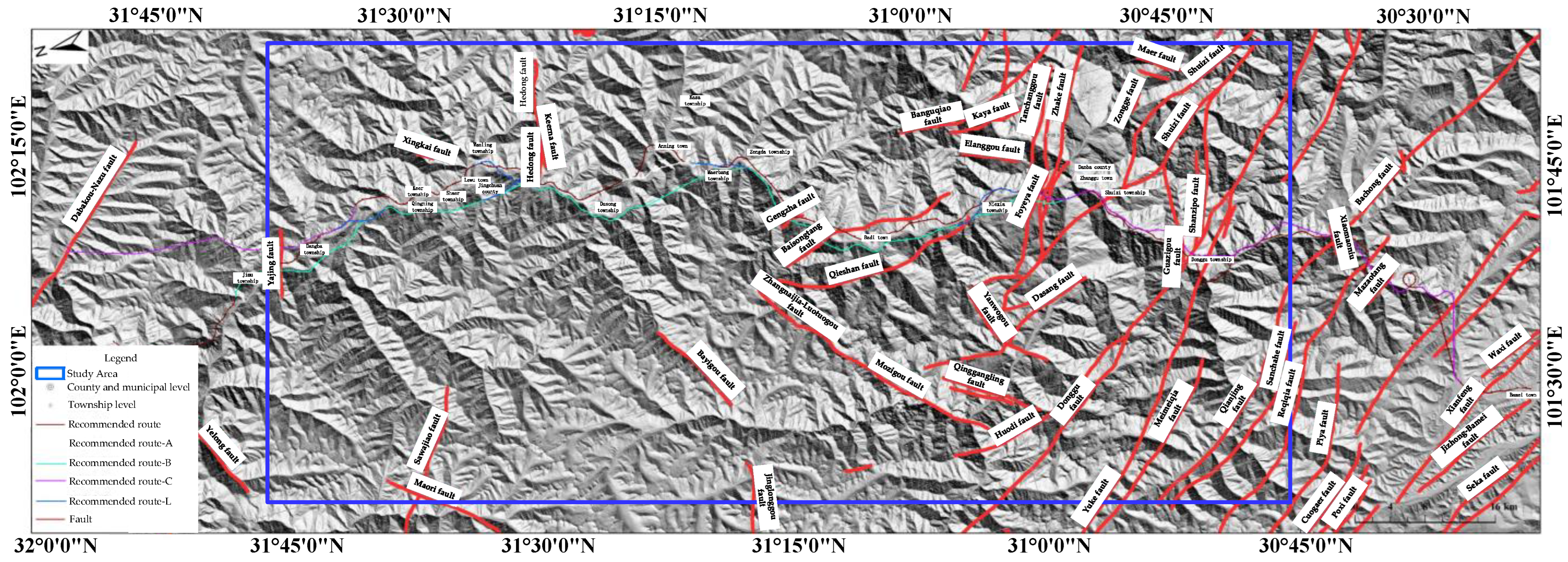
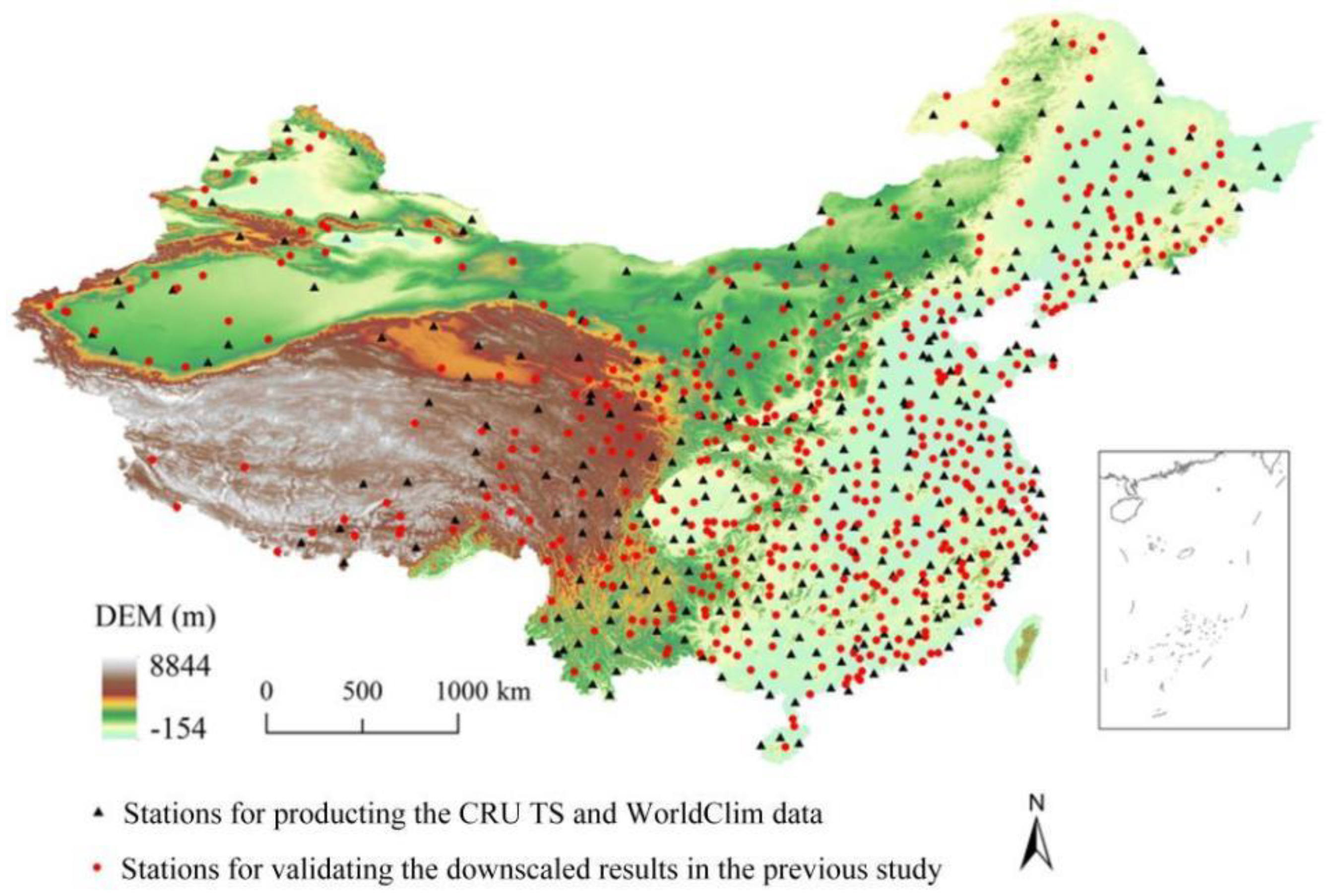
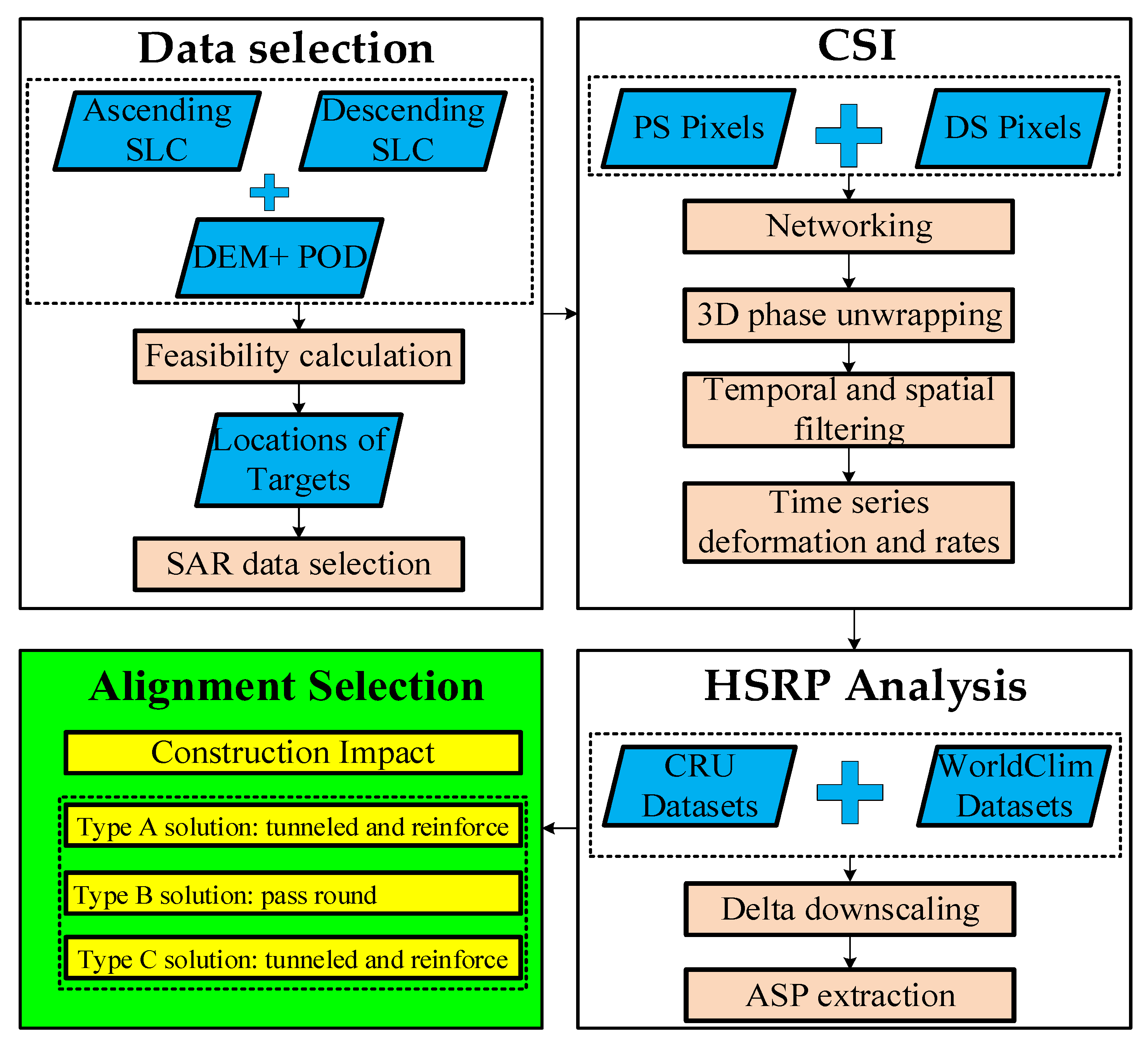

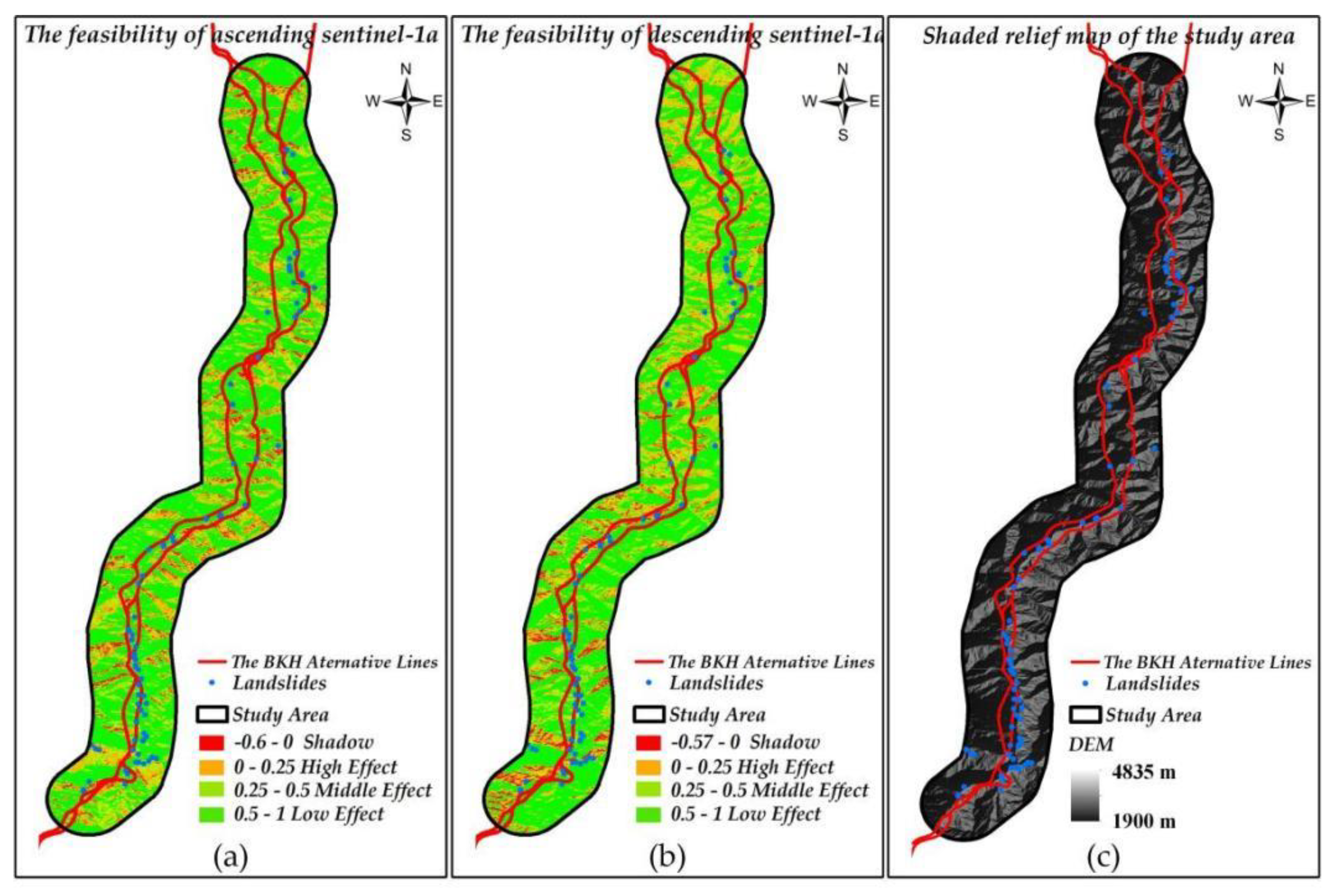
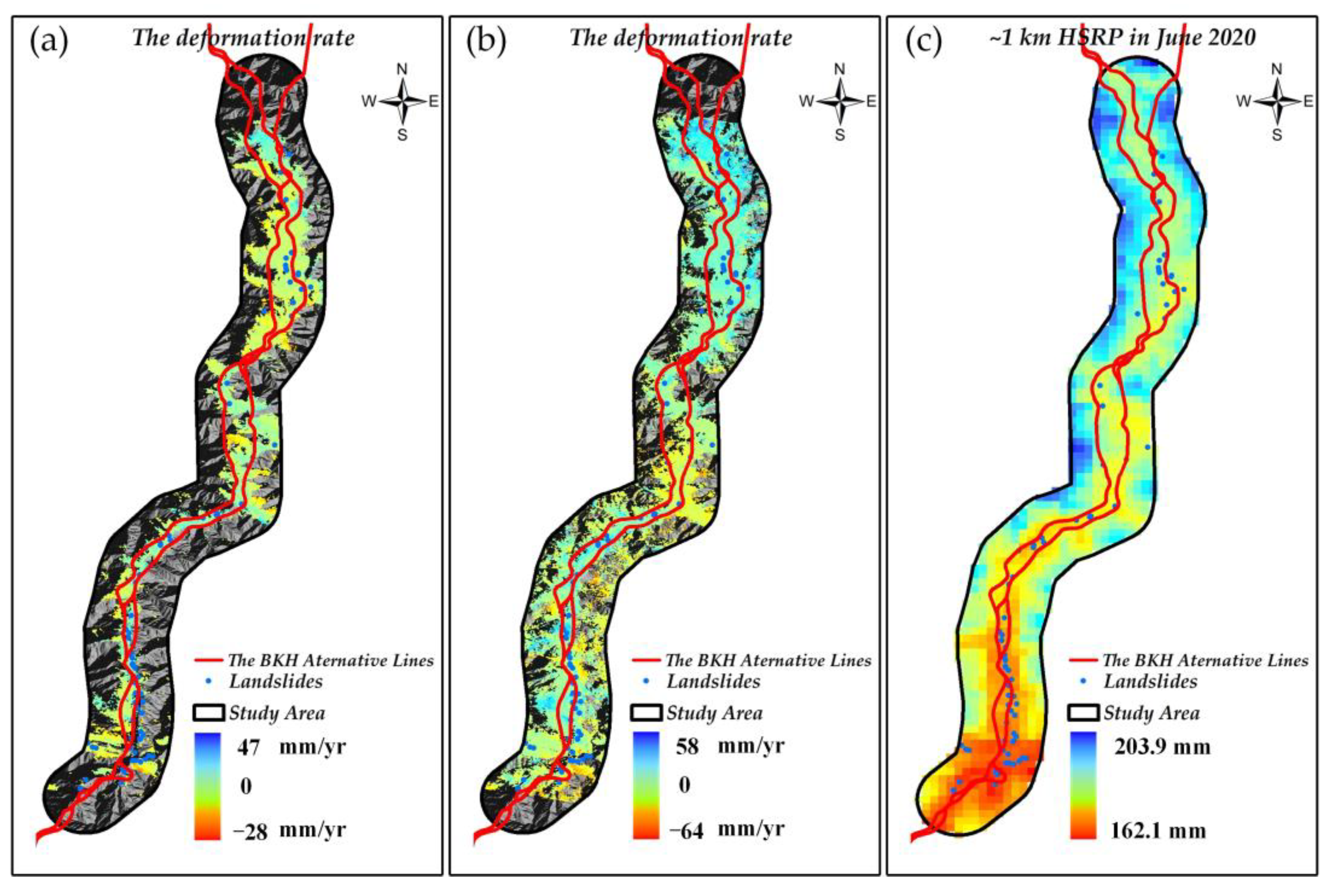
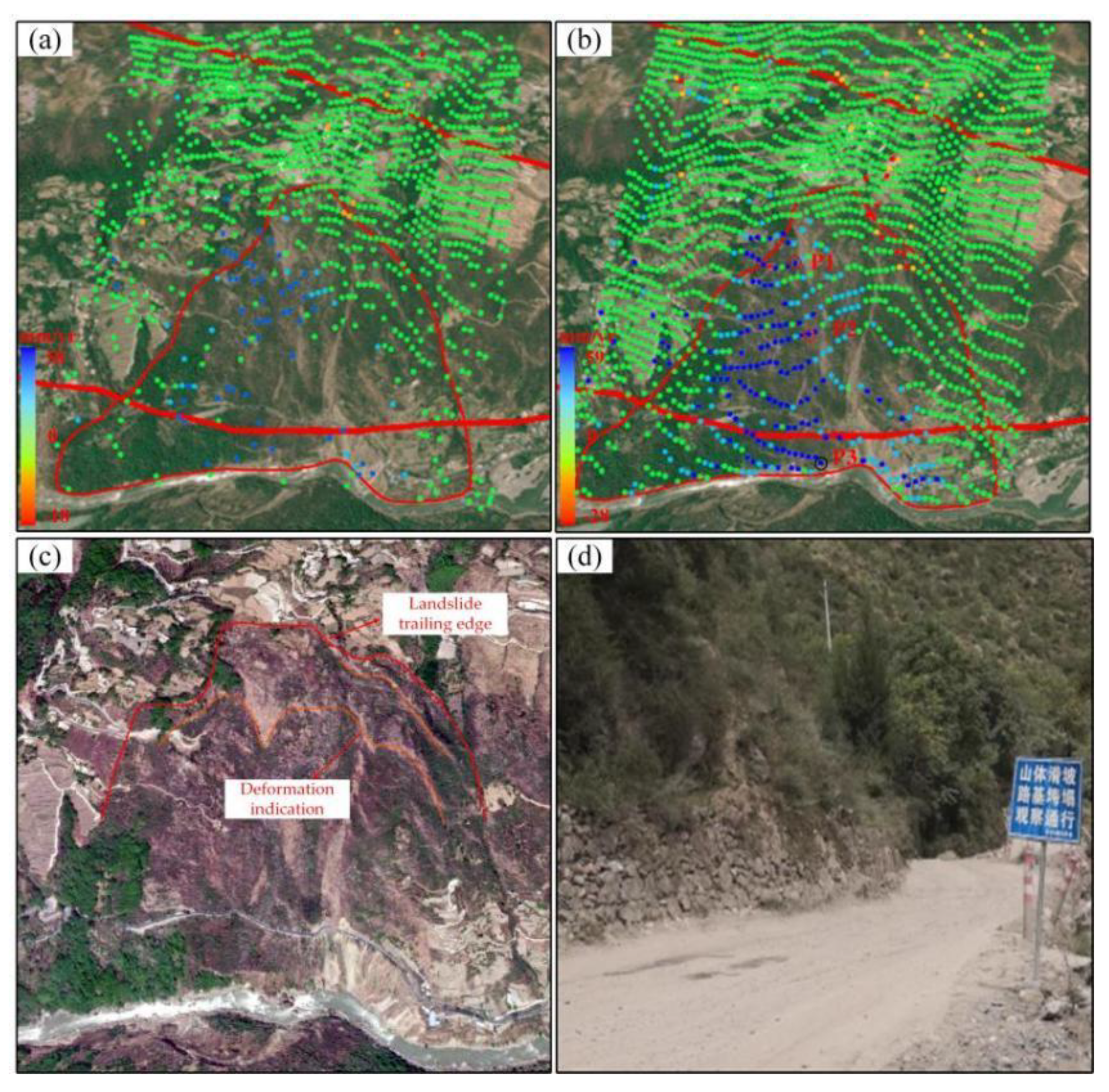
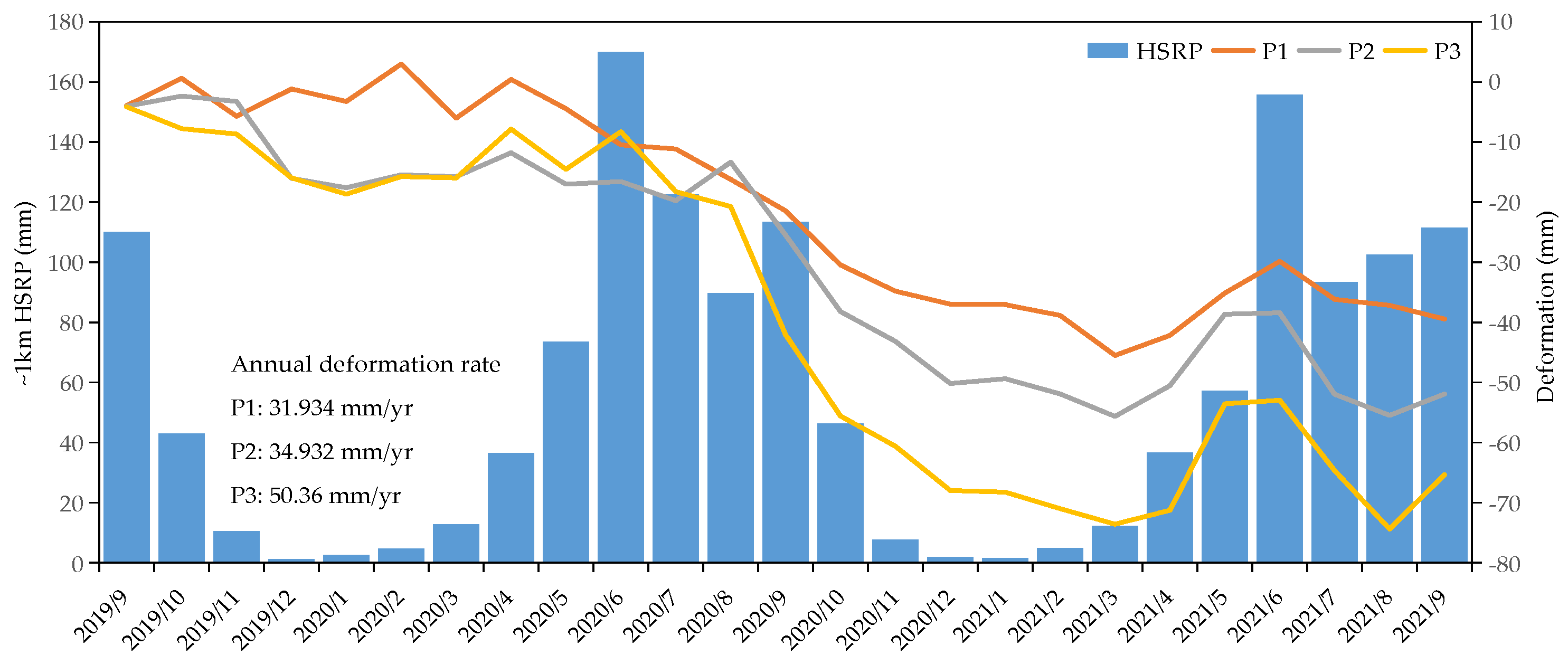
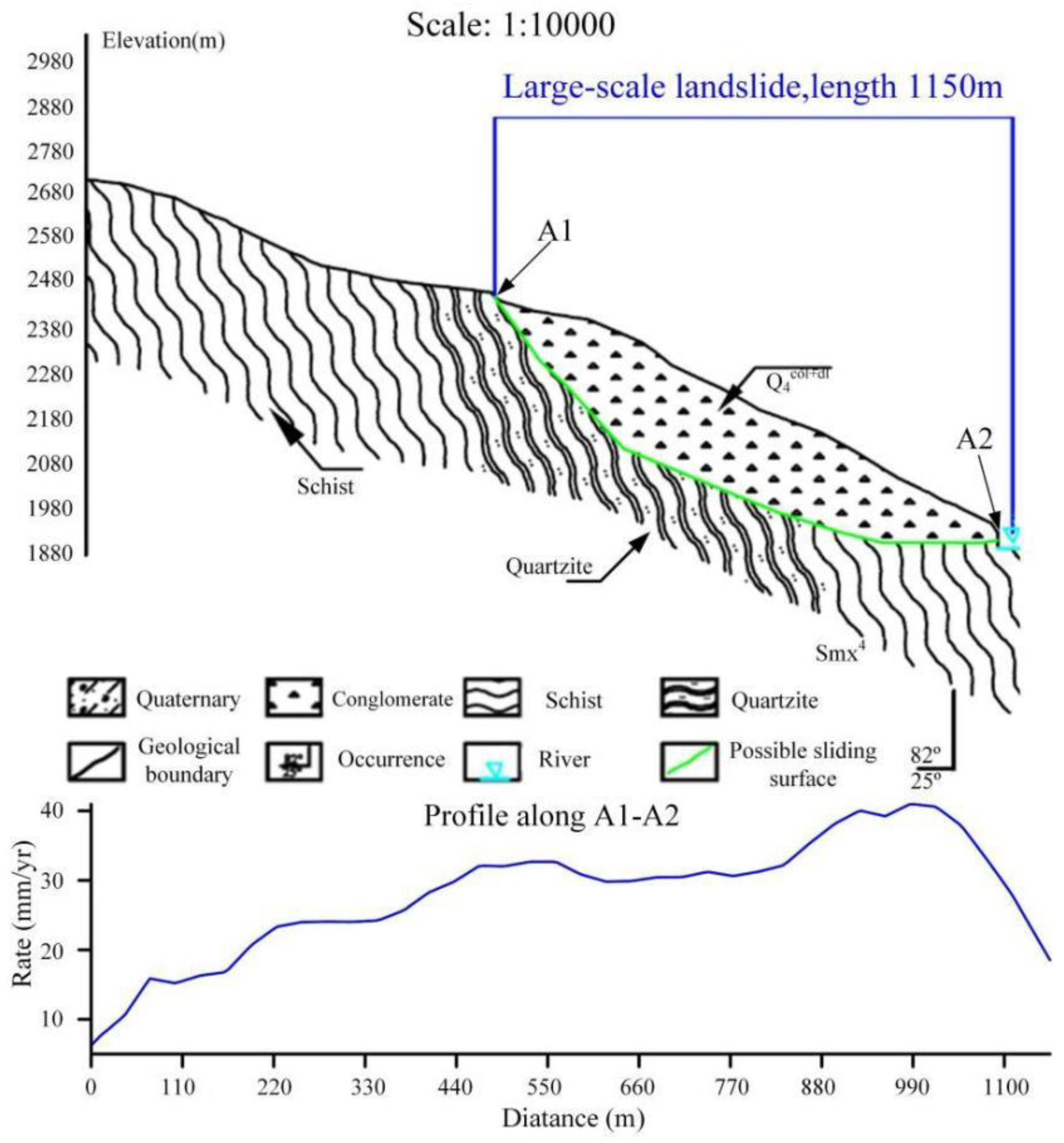
| Sensor Orbit | Time Span | Number of Images | Heading Angle/(°) | Incidence Angle/(°) | Resolution (Range × Azimuth) /m × m |
|---|---|---|---|---|---|
| Descending | 201909~202109 | 56 | −169.58 | 33.74 | 2.33 × 13.97 |
| Value | Type |
|---|---|
| FS ≤ 0 | Shadow/Layover/Flat Area |
| 0 ≤ FS ≤ 0.25 | High Effect |
| 0.25 ≤ FS ≤ 0.5 | Moderate Effect |
| 0.5 ≤ FS ≤ 1 | Low Effect |
| Number | Longitude (°) | Latitude (°) | Length (m) | Width (m) | Area (m2) | Rate (mm/yr) | ASPMP (mm) | Impact Description | Solution Type |
|---|---|---|---|---|---|---|---|---|---|
| 1 | 101.861 | 30.863 | 460.0 | 240.0 | 110,955 | −29 | 599.2 | Line K and C go through the slope: high impact | B: Select line K and pass around |
| 2 | 101.876 | 30.994 | 224.6 | 179.1 | 36,103 | −21 | 604.65 | Line K goes through the slope’s back edge: high impact | B: Pass around |
| 3 | 101.872 | 31.007 | 117.0 | 226.8 | 19,792 | −15 | 609.45 | Line K goes through the slope’s front edge: high impact | B: Pass around |
| 4 | 101.872 | 31.023 | 610.0 | 600.0 | 313,851 | −36 | 601.55 | Line K goes through the slope: high impact | A: Tunnel and reinforce |
| 5 | 101.871 | 31.013 | 265.2 | 247.4 | 55,614 | −28 | 602.1 | Line K goes through the slope’s front edge: high impact | B: Pass around |
| 6 | 101.876 | 31.102 | 180.0 | 250.0 | 43,172 | −32 | 616.8 | Line B goes through the slope’s back edge: high impact | A: Tunnel and reinforce |
| 7 | 102.024 | 31.260 | 243.0 | 196.8 | 30,926 | −34 | 599.25 | Lines K and B go through the slope’s back edge: high impact | A: Select line K, tunnel, and reinforce |
| 8 | 101.907 | 31.152 | 415.6 | 193.1 | 76,215 | 10 | 581.75 | Line B goes through the slope: high impact | C: Remain and reinforce |
| 9 | 101.871 | 30.905 | 531.5 | 300.6 | 109,892 | −30 | 613.25 | Line K goes through the slope’s back edge: low impact | A: Tunnel and reinforce |
| 10 | 101.876 | 30.963 | 1149.9 | 1200.0 | 1,275,267 | 36 | 598.75 | Lines K and B go through the slope: high impact | A: Select line K, tunnel, and reinforce |
| 11 | 101.962 | 31.183 | 169.9 | 211.4 | 30,127 | −5 | 579 | Line B goes through the slope’s back edge: high impact | C: Remain and reinforce |
| 12 | 101.980 | 31.189 | 209.3 | 107.7 | 16,909 | −5 | 573.35 | Line B goes through the slope: high impact | C: Remain and reinforce |
| 13 | 101.978 | 31.187 | 149.1 | 85.4 | 10,381 | 8 | 573.35 | Line B goes through the slope: high impact | C: Remain and reinforce |
| 14 | 101.918 | 31.161 | 137.2 | 207.3 | 22,280 | −10 | 581.8 | Line K goes through the slope’s back edge: low impact | C: Remain and reinforce |
| 15 | 101.889 | 31.145 | 1346.6 | 297.9 | 432,689 | −30 | 598.75 | Line B goes through the slope: high impact | A: Tunnel and reinforce |
| 16 | 102.063 | 31.647 | 1085.4 | 535.2 | 401,586 | −39 | 598.75 | Lines K and A go through the slope: high impact | A: Select line K, tunnel, and reinforce |
| 17 | 102.075 | 31.519 | 318.2 | 149.6 | 42,757 | −16 | 600.55 | Line K goes through the slope’s front edge: high impact | B: Pass around |
| 18 | 102.073 | 31.518 | 354.6 | 155.3 | 45,747 | 11 | 600.55 | Line K goes through the slope: high impact | B: Pass around |
| 19 | 102.082 | 31.492 | 220.1 | 97.3 | 18,410 | −17 | 598.65 | Line K goes through the slope’s front edge: low impact | B: Pass around |
| 20 | 102.081 | 31.490 | 236.1 | 101.9 | 20,605 | 6 | 581.6 | Line K goes through the slope: high impact | C: Remain and reinforce |
| 21 | 101.864 | 31.042 | 344.6 | 230.8 | 66,631 | 12 | 598.65 | Line B goes through the slope: high impact | B: Pass around |
| 22 | 101.867 | 31.032 | 263.7 | 296.9 | 41,838 | −19 | 600.55 | Line K goes through the slope’s back edge: high impact | B: Pass around |
| 23 | 101.863 | 31.044 | 309.8 | 133.3 | 33,968 | 19 | 598.9 | Line B goes through the slope: high impact | B: Pass around |
| 24 | 101.873 | 30.928 | 1209.7 | 630.2 | 628,053 | 30 | 599.85 | Line B goes through the slope: high impact | A: Tunnel and reinforce |
| 25 | 101.879 | 30.943 | 460.6 | 287.9 | 107,688 | −18 | 598.65 | Line B goes through the slope: high impact | A: Tunnel and reinforce |
| 26 | 101.876 | 30.951 | 1458.0 | 681.7 | 773,964 | 18 | 598.8 | Line B goes through the slope: high impact | A: Tunnel and reinforce |
| 27 | 101.876 | 30.975 | 527.4 | 437.0 | 178,659 | −18 | 598.9 | Line B goes through the slope’s back edge: moderate impact | A: Tunnel and reinforce |
| 28 | 101.884 | 30.937 | 195.9 | 107.6 | 17,307 | −20 | 618.95 | Line K goes through the slope: high impact | B: Pass around |
| 29 | 101.879 | 30.982 | 110.6 | 67.2 | 7167 | −18 | 611 | Line K goes through the slope’s back edge: high impact | B: Pass around |
| 30 | 101.872 | 30.997 | 169.2 | 94.1 | 11,256 | −7 | 584.35 | Line K goes through the slope’s back edge: high impact | C: Remain and reinforce |
| 31 | 101.872 | 30.999 | 158.2 | 109.3 | 13,131 | −17 | 610.15 | Line K goes through the slope’s back edge: high impact | B: Pass around |
| 32 | 101.870 | 31.012 | 116.3 | 90.5 | 8210 | −24 | 609.45 | Line K goes through the slope: high impact | B: Pass around |
| 33 | 101.881 | 31.112 | 212.5 | 170.3 | 25,372 | 13 | 616.25 | Line K goes through the slope’s back edge: high impact | B: Pass around |
| 34 | 101.920 | 31.155 | 124.9 | 68.6 | 6905 | 10 | 580.95 | Line K goes through the slope: high impact | C: Remain and reinforce |
| 35 | 101.871 | 31.008 | 118.5 | 96.3 | 8192 | −29 | 609.45 | Line K goes through the slope’s front edge: high impact | B: Pass around |
| 36 | 102.079 | 31.445 | 260.0 | 200.0 | 46,657 | 30 | 600.6 | Line K goes through the slope: high impact | A: Tunnel and reinforce |
| 37 | 101.996 | 31.253 | 603.0 | 433.0 | 223,674 | −36 | 598.6 | Line K goes through the slope: high impact | A: Tunnel and reinforce |
Disclaimer/Publisher’s Note: The statements, opinions and data contained in all publications are solely those of the individual author(s) and contributor(s) and not of MDPI and/or the editor(s). MDPI and/or the editor(s) disclaim responsibility for any injury to people or property resulting from any ideas, methods, instructions or products referred to in the content. |
© 2024 by the authors. Licensee MDPI, Basel, Switzerland. This article is an open access article distributed under the terms and conditions of the Creative Commons Attribution (CC BY) license (https://creativecommons.org/licenses/by/4.0/).
Share and Cite
Wang, Z.; Jia, Y.; Li, S.; Zhang, R.; Xu, B.; Sun, X. Landslide-Hazard-Avoiding Highway Alignment Selection in Mountainous Regions Based on SAR Images and High-Spatial-Resolution Precipitation Datasets: A Case Study in Southwestern China. Remote Sens. 2024, 16, 1303. https://doi.org/10.3390/rs16071303
Wang Z, Jia Y, Li S, Zhang R, Xu B, Sun X. Landslide-Hazard-Avoiding Highway Alignment Selection in Mountainous Regions Based on SAR Images and High-Spatial-Resolution Precipitation Datasets: A Case Study in Southwestern China. Remote Sensing. 2024; 16(7):1303. https://doi.org/10.3390/rs16071303
Chicago/Turabian StyleWang, Zhiheng, Yang Jia, Shengfu Li, Rui Zhang, Binzhi Xu, and Xiaopeng Sun. 2024. "Landslide-Hazard-Avoiding Highway Alignment Selection in Mountainous Regions Based on SAR Images and High-Spatial-Resolution Precipitation Datasets: A Case Study in Southwestern China" Remote Sensing 16, no. 7: 1303. https://doi.org/10.3390/rs16071303
APA StyleWang, Z., Jia, Y., Li, S., Zhang, R., Xu, B., & Sun, X. (2024). Landslide-Hazard-Avoiding Highway Alignment Selection in Mountainous Regions Based on SAR Images and High-Spatial-Resolution Precipitation Datasets: A Case Study in Southwestern China. Remote Sensing, 16(7), 1303. https://doi.org/10.3390/rs16071303







